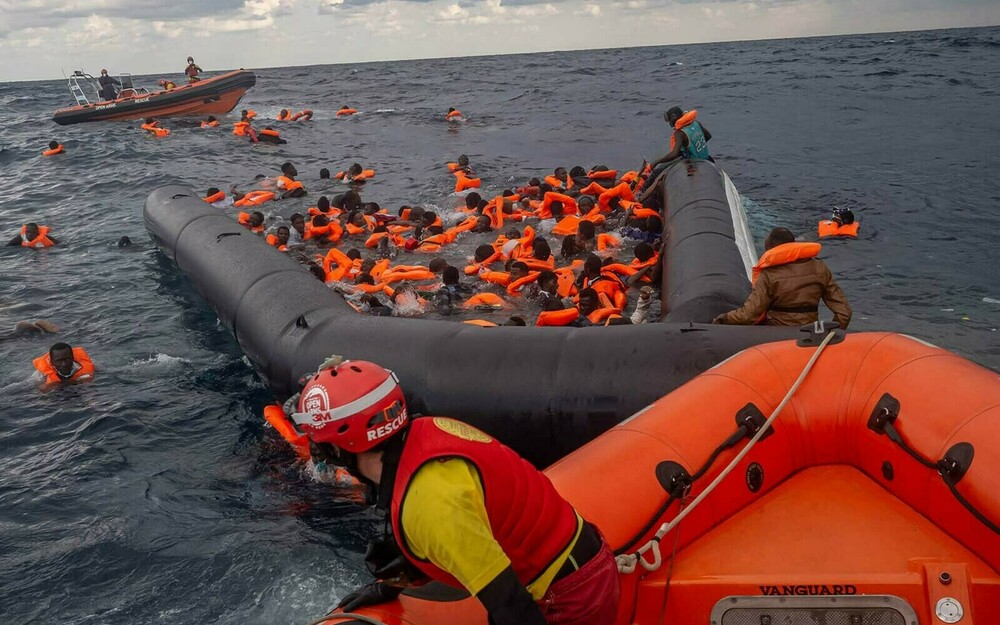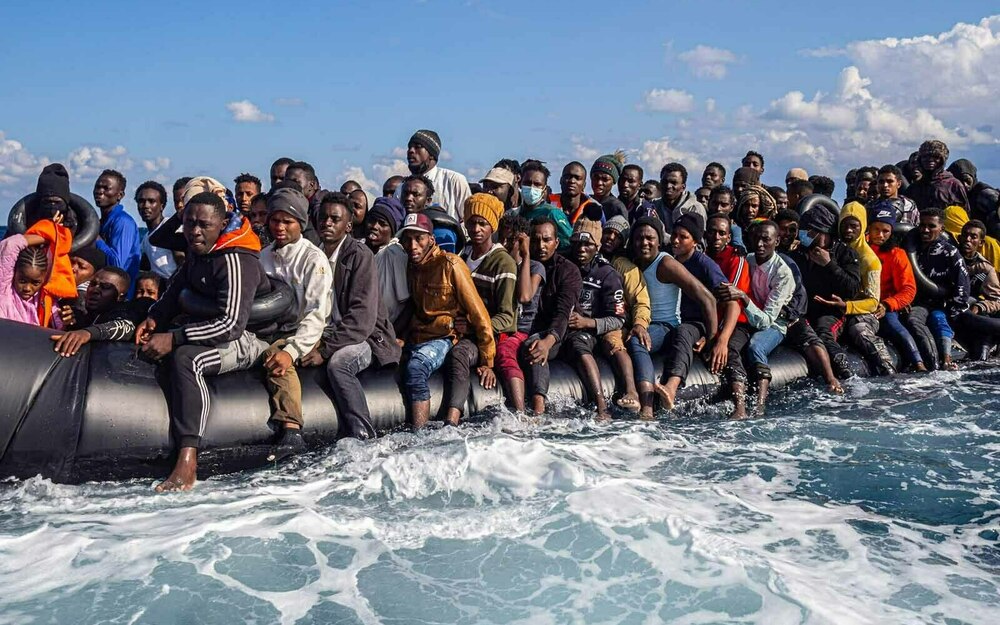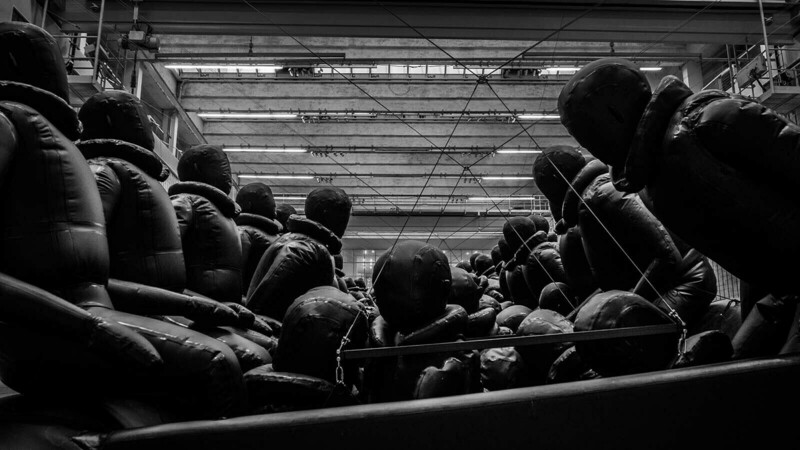
Law of the Journey & Europe's Forgotten Graveyard
Ai Weiwei and Jean-Marc Joseph
Search for Safety: Refugees Blinded from European Society
By: Monay Licata ’25
In a statement about this work on migration, Ai Weiwei remarked, “There’s no refugee crisis, but only human crisis… In dealing with refugees, we’ve lost our very basic values.” Through his artwork, including installation and film, Weiwei, a leading Chinese contemporary artist, challenges the way that governments and European civil society are dealing with refugees—turning a blind eye and refusing them entry into their countries. As a refugee himself, Weiwei uses his life experiences to inform his artistic work on the refugee crisis. His work serves as a forum for human rights activism, cultural commentary, and critique of the global imbalance of power. The humanitarian crisis has become especially dire since 2015, when the influx of refugees into Europe from Syria, Libya, Sudan, and other countries escalated dramatically due to war, economic hardship, and ethnic discrimination. In response, artists have begun mobilizing art as a medium of protest and a way of highlighting the treatment of migrants and refugees.
Since 2014, around 2 million refugees have attempted to migrate to Europe from across the Mediterranean, according to the Missing Migrants Project. Their journeys can take anywhere from a few months to several years, forcing them to endure exploitation, hunger, loneliness, and inhumane living conditions. However, even these conditions are often better than those they left behind. As more refugees flow into European nations, Europe grows stricter in its policies granting refugees asylum. For instance, European countries like Hungary, Poland, and the Czech Republic have refused to open their borders to refugees.
Through his installation “Law of the Journey,” which first debuted in the National Gallery in Prague in 2017, Ai Weiwei criticizes the Czech Republic and Europe more broadly for refusing refugees at their borders. Weiwei claims that “the refugee crisis is an important test for humanity .... It is not about refugees, rather, it is about us.” It is about how we as individuals and as nations recognize and respond to the struggles these refugees endure. “Law of the Journey” is a 3-D installation depicting a 60-meter-long boat filled with more than 300 faceless refugee men, women, and children. The installation is composed entirely of rubber from the same company that manufactures the dinghies used by migrants to cross the Mediterranean Sea.
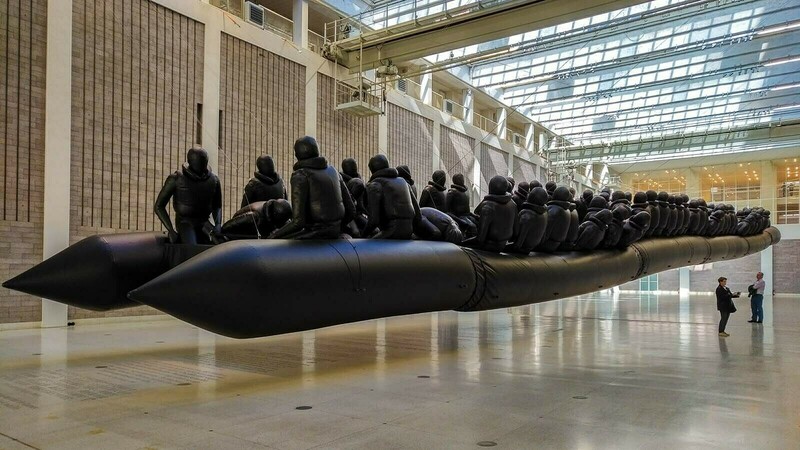
"Ai WeiWei: Law of the Journey," photo by Gilbert Sopakuwa. Used under Creative Commons CC BY-NC-ND 2.0 via Flickr.
The figures’ lack of faces might be seen as a symbol of immigrants’ human desire for home and a sense of belonging. Further, this absence also signifies their dehumanization as projected on them by European societies. Weiwei further explores the effects of this crisis elsewhere, as in his 2017 film “Human Flow,” which tells the stories of refugees in 23 different countries. His emphasis on the deeply personal human impact of mass migration calls viewers to empathize, reflect, and act for the sake of the refugees’ humanity as if each of them were one of us.
Some artists and visual storytellers, including Jean-Marc Joseph, have used visual media to document the harrowing experiences of refugees at sea. Joseph created a documentary titled “Europe’s Forgotten Graveyard,” accompanied by a photo series depicting the inhumane and hidden reality that occurs daily in the Mediterranean. In his 23-minute documentary, Joseph records his experience in 2020 on board the Open Arms, a volunteer search boat operating in the Mediterranean looking for migrant boats in distress.
Photos taken while filming Europe's Forgotten Graveyard. Used with permission from Jean-Marc Joseph.
Joseph recounts in his documentary how “despite the legal obligation to assist people in distress at sea, governments and merchant ships often turn a blind eye to calls for help when it comes from migrants.” However, NGOs like Open Arms are stepping in to help save migrants lost at sea. In Joseph’s documentary, for instance, during the rescue of a migrant raft holding 118 refugees, the vessel suddenly breaks apart, tossing everyone into the sea. Most of the migrants can’t swim and begin to drown. Joseph puts down the video camera and helps people out of the water himself. He reflects, “I joined this mission to witness and report, but now a tragedy is unfolding in front of me... and I’m part of it.” In an important sense, we are all part of it. Joseph’s heroic action of not only documenting the journeys of these refugees but also stepping beyond the camera and acting is what his work challenges viewers to do. By bringing to light these atrocities endured by human beings, he urges viewers, politicians, and governments to act.
These examples of art and documentary film not only comment on the conditions and displacement endured by refugees but they also pose a call to action and denounce the silence of political and civic institutions. They document the horrific conditions and dangers experienced by refugees at sea, and they seek to represent their stories. According to Ai Weiwei, “In this time of uncertainty, we need more tolerance, compassion, and trust for each other since we all are one. Otherwise, humanity will face an even bigger crisis.”

Monay Licata is a junior studying marketing and global affairs. She is originally from Grand Junction, Colorado, and currently resides in Cavanaugh Hall on Campus. She is passionate about travel, human development, social entrepreneurship, and all things outdoors. In fact, she has been to 23 national parks. On campus, Monay is involved in the Student Union Board, Student Government, Design for America, the Balfour Scholars program, and the Business Honors Program.
Research by: Monay Licata
Artists: Ai Weiwei and Jean-Marc Joseph
Theme: Migration
Header image: “Ai Weiwei. Law of The Journey,” photo by: alskikof. Used under Creative Commons CC BY-NC-SA 2.0 via Flickr.
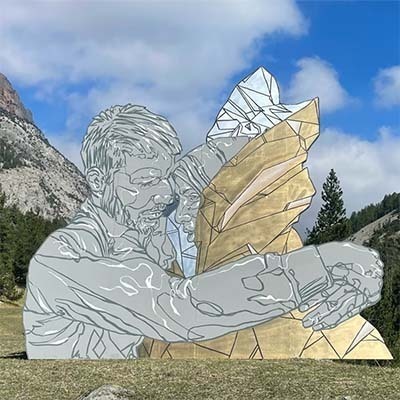
Fragments de Voyages
Art by Mahn Kloix, research by Ethan Chiang
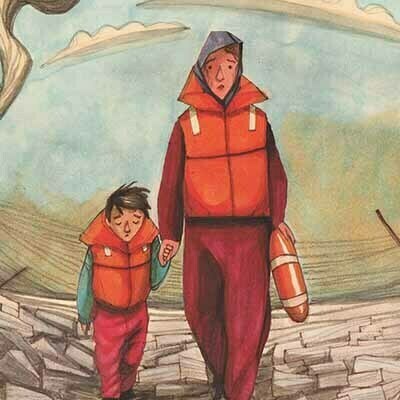
Life Jacket
Art by Diala Brisly, research by Anna Gazewood
